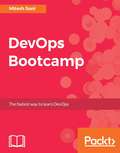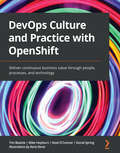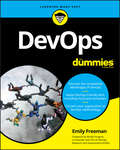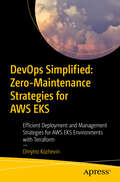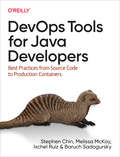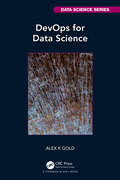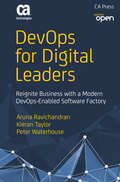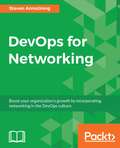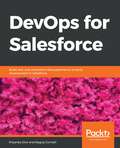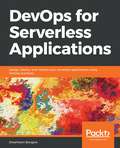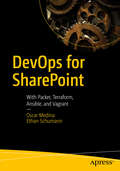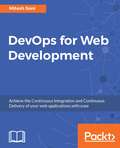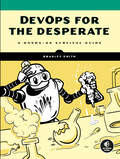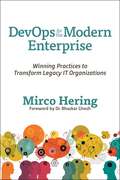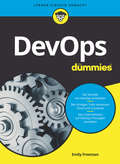- Table View
- List View
DevOps Bootcamp
by Mitesh SoniSharpen your DevOps knowledge with DevOps Bootcamp About This Book • Improve your organization's performance to ensure smooth production of software and services. • Learn how Continuous Integration and Continuous Delivery practices can be utilized to cultivate the DevOps culture. • A fast-paced guide filled with illustrations and best practices to help you consistently ship quality software. Who This Book Is For The book is aimed at IT Developers and Operations—administrators who want to quickly learn and implement the DevOps culture in their organization. What You Will Learn • Static Code Analysis using SOnarqube • Configure a Maven-based JEE Web Application • Perform Continuous Integration using Jenkins and VSTS • Install and configure Docker • Converge a Chef node using a Chef workstation • Accomplish Continuous Delivery in Microsoft Azure VM and Microsoft Azure App Services (Azure Web Apps) using Jenkins • Perform Load Testing using Apache JMeter • Build and Release Automation using Visual Studio Team Services • Monitor Cloud-based resources In Detail DevOps Bootcamp delivers practical learning modules in manageable chunks. Each chunk is delivered in a day, and each day is a productive one. Each day builds your competency in DevOps. You will be able to take the task you learn every day and apply it to cultivate the DevOps culture. Each chapter presents core concepts and key takeaways about a topic in DevOps and provides a series of hands-on exercises. You will not only learn the importance of basic concepts or practices of DevOps but also how to use different tools to automate application lifecycle management. We will start off by building the foundation of the DevOps concepts. On day two, we will perform Continuous Integration using Jenkins and VSTS both by configuring Maven-based JEE Web Application?. We will also integrate Jenkins and Sonar qube for Static Code Analysis. Further, on day three, we will focus on Docker containers where we will install and configure Docker and also create a Tomcat Container to deploy our Java based web application. On day four, we will create and configure the environment for application deployment in AWS and Microsoft Azure Cloud for which we will use Infrastructure as a Service and Open Source Configuration Management tool Chef. For day five, our focus would be on Continuous Delivery. We will automate application deployment in Docker container using Jenkins Plugin, AWS EC2 using Script, AWS Elastic Beanstalk using Jenkins Plugin, Microsoft Azure VM using script, and Microsoft Azure App Services Using Jenkins. We will also configure Continuous Delivery using VSTS. We will then learn the concept of Automated Testing on day six using Apache JMeter and URL-based tests in VSTS. Further, on day seven, we will explore various ways to automate application lifecycle management using orchestration. We will see how Pipeline can be created in Jenkins and VSTS, so the moment Continuous? Integration is completed successfully, Continuous Delivery will start and application will be deployed. On the final day, our focus would be on Security access to Jenkins and Monitoring of CI resources, and cloud-based resources in AWS and Microsoft Azure Platform as a Service. Style and Approach This book is all about fast and intensive learning. This means we don't waste time in helping readers get started. The new content is basically about filling in with highly-effective examples to build new things, solving problems in newer and unseen ways, and solving real-world examples.
DevOps Culture and Practice with OpenShift: Deliver continuous business value through people, processes, and technology
by Mike Hepburn Noel O'Connor Tim Beattie Donal SpringA practical guide to making the best use of the OpenShift container platform based on the real-life experiences, practices, and culture within Red Hat Open Innovation LabsKey FeaturesLearn how modern software companies deliver business outcomes that matter by focusing on DevOps culture and practicesAdapt Open Innovation Labs culture and foundational practices from the Open Practice LibraryImplement a metrics-driven approach to application, platform, and product, understanding what to measure and how to learn and pivotBook DescriptionDevOps Culture and Practice with OpenShift features many different real-world practices - some people-related, some process-related, some technology-related - to facilitate successful DevOps, and in turn OpenShift, adoption within your organization. It introduces many DevOps concepts and tools to connect culture and practice through a continuous loop of discovery, pivots, and delivery underpinned by a foundation of collaboration and software engineering.Containers and container-centric application lifecycle management are now an industry standard, and OpenShift has a leading position in a flourishing market of enterprise Kubernetes-based product offerings. DevOps Culture and Practice with OpenShift provides a roadmap for building empowered product teams within your organization.This guide brings together lean, agile, design thinking, DevOps, culture, facilitation, and hands-on technical enablement all in one book. Through a combination of real-world stories, a practical case study, facilitation guides, and technical implementation details, DevOps Culture and Practice with OpenShift provides tools and techniques to build a DevOps culture within your organization on Red Hat's OpenShift Container Platform.What you will learnImplement successful DevOps practices and in turn OpenShift within your organizationDeal with segregation of duties in a continuous delivery worldUnderstand automation and its significance through an application-centric viewManage continuous deployment strategies, such as A/B, rolling, canary, and blue-greenLeverage OpenShift's Jenkins capability to execute continuous integration pipelinesManage and separate configuration from static runtime softwareMaster communication and collaboration enabling delivery of superior software products at scale through continuous discovery and continuous deliveryWho this book is forThis book is for anyone with an interest in DevOps practices with OpenShift or other Kubernetes platforms.This DevOps book gives software architects, developers, and infra-ops engineers a practical understanding of OpenShift, how to use it efficiently for the effective deployment of application architectures, and how to collaborate with users and stakeholders to deliver business-impacting outcomes.
DevOps For Dummies
by Emily FreemanDevelop faster with DevOps DevOps embraces a culture of unifying the creation and distribution of technology in a way that allows for faster release cycles and more resource-efficient product updating. DevOps For Dummies provides a guidebook for those on the development or operations side in need of a primer on this way of working. Inside, DevOps evangelist Emily Freeman provides a roadmap for adopting the management and technology tools, as well as the culture changes, needed to dive head-first into DevOps. Identify your organization’s needs Create a DevOps framework Change your organizational structure Manage projects in the DevOps world DevOps For Dummies is essential reading for developers and operations professionals in the early stages of DevOps adoption.
DevOps Paradox: The truth about DevOps by the people on the front line
by Viktor FarcicDiscover DevOps secrets from leading experts. Viktor Farcic interviews DevOps industries voices including Mike Kail, Greg Bledsoe, Jeff Sussna, James Turnbull, Kohsuke Kawaguchi, Liz Keogh, and more. Key Features Leading DevOps experts share their insights into modern DevOps practice Engage with the real-world challenges of putting DevOps to work Strengthen your DevOps practices now and prepare for future DevOps trends Book Description DevOps promises to break down silos, uniting organizations to deliver high quality output in a cross-functional way. In reality it often results in confusion and new silos: pockets of DevOps practitioners fight the status quo, senior decision-makers demand DevOps paint jobs without committing to true change. Even a clear definition of what DevOps is remains elusive. In DevOps Paradox, top DevOps consultants, industry leaders, and founders reveal their own approaches to all aspects of DevOps implementation and operation. Surround yourself with expert DevOps advisors. Viktor Farcic draws on experts from across the industry to discuss how to introduce DevOps to chaotic organizations, align incentives between teams, and make use of the latest tools and techniques. With each expert offering their own opinions on what DevOps is and how to make it work, you will be able to form your own informed view of the importance and value of DevOps as we enter a new decade. If you want to see how real DevOps experts address the challenges and resolve the paradoxes, this book is for you. What you will learn Expert opinions on: Introducing DevOps into real-world, chaotic business environments Deciding between adopting cutting edge tools or sticking with tried-and-tested methods Initiating necessary business change without positional power Managing and overcoming fear of change in DevOps implementations Anticipating future trends in DevOps and how to prepare for them Getting the most from Kubernetes, Docker, Puppet, Chef, and Ansible Creating the right incentives for DevOps success across an organization The impact of new techniques, such as Lambda, serverless, and schedulers, on DevOps practice Who this book is for Anybody interested in DevOps will gain a lot from this book. If you want to get beyond the simplistic ideals and engage with the deep challenges of putting DevOps to work in the real world, this book is for you.
DevOps Simplified: Efficient Deployment and Management Strategies for AWS EKS Environments with Terraform
by Dmytro KozhevinGain the knowledge and practical skills needed to deploy a fully functional, secure, and scalable application in AWS EKS. This book is a hands-on guide designed to help you navigate and manage infrastructure in the AWS EKS environment. The book starts by reviewing the concept of DevOps flexibility, emphasizing adaptability to manage changes effectively. It covers foundational elements like IAM basics, user management, and the use of Terraform for infrastructure as code, highlighting the importance of version stability and unique CIDR blocks. Moving forward, you’ll explore Kubernetes, and its initial set-up steps, such as configuration management, access control, and storage. You’ll also see how to bridge Kubernetes with AWS resources, touching upon service accounts, identity federation, and policy assignment. In the final chapters, the book guides you through the complete setup of a fully working application using Terraform. The book culminates with a step-by-step walkthrough of deploying a complete application environment where you’ll generate and distribute access credentials, configure persistent storage, and manage RBAC for users, all using Terraform. Zero-Maintenance Strategies for AWS EKS will provide you with a solid foundation and a toolkit of proven strategies for managing cloud infrastructure. What You Will Learn Understand the concept of DevOps flexibility and its practical applications Acquire foundational knowledge in IAM basics and user management. Manage external access to your applications while consolidating load balancing through a single, entry point. Securely configure DNS and SSL, ensuring your application is both accessible and protected. Who This Book Is For DevOps professionals, IT managers, and software developers who are looking to adopt or improve their DevOps practices, and students and educators in IT-related fields.
DevOps Tools for Java Developers: Best Practices from Source Code to Production Containers
by Stephen Chin Melissa McKay Ixchel Ruiz Baruch SadogurskyWith the rise of DevOps, low-cost cloud computing, and container technologies, the way Java developers approach development today has changed dramatically. This practical guide helps you take advantage of microservices, serverless, and cloud native technologies using the latest DevOps techniques to simplify your build process and create hyperproductive teams.Stephen Chin, Melissa McKay, Ixchel Ruiz, and Baruch Sadogursky from JFrog help you evaluate an array of options. The list includes source control with Git, build declaration with Maven and Gradle, CI/CD with CircleCI, package management with Artifactory, containerization with Docker and Kubernetes, and much more. Whether you're building applications with Jakarta EE, Spring Boot, Dropwizard, MicroProfile, Micronaut, or Quarkus, this comprehensive guide has you covered.Explore software lifecycle best practicesUse DevSecOps methodologies to facilitate software development and deliveryUnderstand the business value of DevSecOps best practicesManage and secure software dependenciesDevelop and deploy applications using containers and cloud native technologiesManage and administrate source control repositories and development processesUse automation to set up and administer build pipelinesIdentify common deployment patterns and antipatternsMaintain and monitor software after deployment
DevOps for Airborne Software: Exploring Modern Approaches (SpringerBriefs in Computer Science)
by Umut Durak Wanja ZaeskeThis Springer Brief presents a selection of tools and techniques which either enable or improve the use of DevOps for airborne software engineering. They are evaluated against the unique challenges of the aviation industry such as safety and airworthiness, and exercised using a demonstrator in order to gather first experience. The book is structured as follows: after a short introduction to the main topics of the work in chapter 1, chapter 2 provides more information on the tools, techniques, software and standards required to implement the subsequently presented ideas. In particular, the development practice BDD, the relation between DevOps, CI & CD and both the Rust & the Nix programming language are introduced. In chapter 3 the authors explain and justify their ideas towards advancing the state of the art, mapping the aforementioned tools and techniques to the DevOps Cycle while considering aspects of Do-178C. Next, in chapter 4 the experiences gathered while implementing a demonstrator using the tools and techniques are described. Eventually, chapter 5 briefly summarizes the findings and presents a compilation of open points and missing pieces which are yet to be resolved. The book targets three different reader groups. The first one are development managers from the aerospace industry who need to see examples and experience reports for the application of DevOps for airborne software. The second group are investigators in the safety-critical embedded systems domain who look for benchmarks at various application domains. And the third group are lecturers who offer graduate level software engineering courses for safety-critical software engineering.
DevOps for Data Science (Chapman & Hall/CRC Data Science Series)
by Alex GoldData Scientists are experts at analyzing, modelling and visualizing data but, at one point or another, have all encountered difficulties in collaborating with or delivering their work to the people and systems that matter. Born out of the agile software movement, DevOps is a set of practices, principles and tools that help software engineers reliably deploy work to production. This book takes the lessons of DevOps and aplies them to creating and delivering production-grade data science projects in Python and R.This book’s first section explores how to build data science projects that deploy to production with no frills or fuss. Its second section covers the rudiments of administering a server, including Linux, application, and network administration before concluding with a demystification of the concerns of enterprise IT/Administration in its final section, making it possible for data scientists to communicate and collaborate with their organization’s security, networking, and administration teams.Key Features:• Start-to-finish labs take readers through creating projects that meet DevOps best practices and creating a server-based environment to work on and deploy them.• Provides an appendix of cheatsheets so that readers will never be without the reference they need to remember a Git, Docker, or Command Line command.• Distills what a data scientist needs to know about Docker, APIs, CI/CD, Linux, DNS, SSL, HTTP, Auth, and more.• Written specifically to address the concern of a data scientist who wants to take their Python or R work to production.There are countless books on creating data science work that is correct. This book, on the otherhand, aims to go beyond this, targeted at data scientists who want their work to be than merely accurate and deliver work that matters.
DevOps for Digital Leaders
by Aruna Ravichandran Kieran Taylor Peter WaterhouseLearn to design, implement, measure, and improve DevOps programs that are tailored to your organization. This concise guide assists leaders who are accountable for the rapid development of high-quality software applications. In DevOps for Digital Leaders, deep collective experience on both sides of the dev-ops divide informs the global thought leadership and penetrating insights of the authors, all three of whom are cross-portfolio DevOps leaders at CA Technologies. Aruna Ravichandran, Kieran Taylor, and Peter Waterhouse analyze the organizational benefits, costs, freedoms, and constraints of DevOps. They chart the coordinated strategy of organizational change, metrics, lean thinking, and investment that an enterprise must undertake to realize the full potential of DevOps and reach the sweet spot where accelerating code deployments drive increasing customer satisfaction, revenue, and profitability. Digital leaders are charged to bridge the dev-ops disconnect if their organizations are to survive and flourish in a business world increasingly differentiated by the degree to which dynamic application software development harmonizes with operational resilience and reliability. This short book applies the DevOps perspective to the competitive challenge, faced by every high-performance IT organization today, of integrating and automating open source, cloud, and enterprise tools, processes, and techniques across the software development life cycle from requirements to release. What You Will Learn: Remove dependencies and constraints so that parallel practices can accelerate the development of defect-free software Automate continuous delivery across the software life cycle to eliminate release bottlenecks, manual labor waste, and technical debt accumulation Generate virtualized production-style testing of applications through real-time behavioral analytics Adopt agile practices so operations teams can support developer productivity with automated feedback, streamline infrastructure monitoring, spot and resolve operations issues before they impact production, and improve customer experience Identify the DevOps metrics appropriate to your organization and integrate DevOps with your existing best practices and investment Who This Book Is For: IT leaders in large companies and government agencies who have any level of responsibility for the rapid development of high-quality software applications. The secondary readership is members of development and operations teams, security professionals, and service managers.
DevOps for Networking
by Steven ArmstrongBoost your organization's growth by incorporating networking in the DevOps culture About This Book * Implement networking fundamentals to the DevOps culture with ease, improving your organization's stability * Leverage various open source tools such as Puppet and Ansible in order to automate your network * This step-by-step learning guide collaborating the functions of developers and network administrators Who This Book Is For The book is aimed for Network Engineers, Developers, IT operations and System admins who are planning to incorporate Networking in DevOps culture and have no knowledge about it. What You Will Learn * Learn about public and private cloud networking using AWS and OpenStack as examples * Explore strategies that can be used by engineers or managers to initiate the cultural changes required to enable the automation of network functions * Learn about SDN and how an API-driven approach to networking can help solve common networking problems * Get the hang of configuration management tools, such as Ansible and Jenkins, that can be used to orchestrate and configure network devices * Setup continuous integration, delivery, and deployment pipelines for network functions * Create test environments for network changes * Understand how load balancing is becoming more software defined with the emergence of microservice applications In Detail Frustrated that your company's network changes are still a manual set of activities that slow developers down? It doesn't need to be that way any longer, as this book will help your company and network teams embrace DevOps and continuous delivery approaches, enabling them to automate all network functions. This book aims to show readers network automation processes they could implement in their organizations. It will teach you the fundamentals of DevOps in networking and how to improve DevOps processes and workflows by providing automation in your network. You will be exposed to various networking strategies that are stopping your organization from scaling new projects quickly. You will see how SDN and APIs are influencing DevOps transformations, which will in turn help you improve the scalability and efficiency of your organizations networks operations. You will also find out how to leverage various configuration management tools such as Ansible, to automate your network. The book will also look at containers and the impact they are having on networking as well as looking at how automation impacts network security in a software-defined network. Style and approach This will be a comprehensive, learning guide for teaching our readers how networking can be leveraged to improve the DevOps culture for any organization.
DevOps for Salesforce: Build, test, and streamline data pipelines to simplify development in Salesforce
by Priyanka Dive Nagraj GornalliImplement DevOps for Salesforce and explore its featuresKey FeaturesLearn DevOps principles and techniques for enterprise operations in SalesforceImplement Continuous Integration and Continuous Delivery using tools such as Jenkins and Ant scriptUse the Force.com Migration Tool and Git to achieve versioning in SalesforceBook DescriptionSalesforce is one of the top CRM tools used these days, and with its immense functionalities and features, it eases the functioning of an enterprise in various areas of sales, marketing, and finance, among others. Deploying Salesforce applications is a tricky event, and it can get quite taxing for admins and consultants. This book addresses all the problems that you might encounter while trying to deploy your applications and shows you how to resort to DevOps to take these challenges head on.Beginning with an overview of the development and delivery process of a Salesforce app, DevOps for Salesforce covers various types of sandboxing and helps you understand when to choose which type. You will then see how different it is to deploy with Salesforce as compared to deploying with another app. You will learn how to leverage a migration tool and automate deployment using the latest and most popular tools in the ecosystem. This book explores topics such as version control and DevOps techniques such as Continuous Integration, Continuous Delivery, and testing. Finally, the book will conclude by showing you how to track bugs in your application changes using monitoring tools and how to quantify your productivity and ROI.By the end of the book, you will have acquired skills to create, test, and effectively deploy your applications by leveraging the features of DevOps.What you will learnImplement DevOps for Salesforce and understand the benefits it offersAbstract the features of Force.com MigrationTool to migrate and retrieve metadataDevelop your own CI/CD Pipeline for Salesforce projectUse Qualitia to perform scriptless automation for Continuous TestingTrack application changes using BugzillaApply Salesforce best practices to implement DevOpsWho this book is forIf you are a Salesforce developer, consultant, or manager who wants to learn DevOps tools and set up pipelines for small as well as large Salesforce projects, this book is for you.
DevOps for Serverless Applications: Design, deploy, and monitor your serverless applications using DevOps practices
by Shashikant BangeraSet up complete CI and CD pipelines for your serverless applications using DevOps principlesKey FeaturesUnderstand various services for designing serverless architecture Build CD pipelines using various cloud providers for your serverless applications Implement DevOps best practices when building serverless applicationsBook DescriptionServerless applications are becoming very popular among developers and are generating a buzz in the tech market. Many organizations struggle with the effective implementation of DevOps with serverless applications. DevOps for Serverless Applications takes you through different DevOps-related scenarios to give you a solid foundation in serverless deployment.You will start by understanding the concepts of serverless architecture and development, and why they are important. Then, you will get to grips with the DevOps ideology and gain an understanding of how it fits into the Serverless Framework. You'll cover deployment framework building and deployment with CI and CD pipelines for serverless applications. You will also explore log management and issue reporting in the serverless environment. In the concluding chapters, you will learn important security tips and best practices for secure pipeline management.By the end of this book, you will be in a position to effectively build a complete CI and CD delivery pipeline with log management for serverless applications.What you will learnExplore serverless fundamentals and effectively combine them with DevOpsSet up CI and CD with AWS Lambda and other popular Serverless service providers with the help of the Serverless FrameworkPerform monitoring and logging with serverless applicationsSet up a dynamic dashboard for different service providersDiscover best practices for applying DevOps to serverless architectureUnderstand use cases for different serverless architecturesWho this book is forDevOps for Serverless Applications is for DevOps engineers, architects, or anyone interested in understanding the DevOps ideology in the serverless world. You will learn to use DevOps with serverless and apply continuous integration, continuous delivery, testing, logging, and monitoring with serverless.
DevOps for SharePoint: With Packer, Terraform, Ansible, and Vagrant
by Oscar Medina Ethan SchumannDeploy a SharePoint farm in a repeatable, predictable, and reliable fashion using Infrastructure as Code (IaC) techniques to automate provisioning. Savvy IT pros will learn how to use DevOps practices and open source tools to greatly reduce costs, and streamline management operations for SharePoint farms deployed via Amazon Web Services (AWS), Azure, or on premise. DevOps for SharePoint will help you navigate the complex challenges of deploying and managing SharePoint Server farms. You will learn how to reduce time-consuming tasks and errors when generating development, testing, or production environments. And you will benefit from learning proven methods to apply Microsoft updates with minimal downtime and productivity loss. Whether you are a SharePoint architect, IT pro, or developer helping customers with the SharePoint platform, this book will teach you the most useful DevOps practices to tackle those issues and broaden your skill set.What You’ll LearnUnderstand the basics of the most popular open source tools—Vagrant, Packer, Terraform, and Ansible—and how to use them in the context of deploying and scaling a SharePoint farmUse Vagrant to build SharePoint development environments in less than an hour, and add automated testingUse Packer to create a “golden image” with preconfigured settings, and then use it as the base image in your Terraform configuration for both AWS and Azure farmsUse Terraform to scale your SharePoint farm topologyUse Red Hat’s Ansible Playbooks to perform configuration management on your farmUse Terraform to deploy immutable infrastructure environments using IaC (Infrastructure as Code)Use InSpec 2.0 to stay in compliance by testing your cloud infrastructureUse Ansible to apply Microsoft updates and patches Who This Book Is ForIT pros and developers who are looking to expand their knowledge and take a modern approach by using open source technologies to work with Microsoft products. Experience installing SharePoint, and a basic understanding of either Azure or AWS, is helpful.
DevOps for Web Development
by Mitesh SoniAchieve the Continuous Integration and Continuous Delivery of your web applications with ease About This Book * Overcome the challenges of implementing DevOps for web applications, familiarize yourself with diverse third-party modules, and learn how to integrate them with bespoke code to efficiently complete tasks * Understand how to deploy web applications for a variety of Cloud platforms such as Amazon EC2, AWS Elastic Beanstalk, Microsoft Azure, Azure Web Apps, and Docker Container * Understand how to monitor applications deployed in Amazon EC2, AWS Elastic Beanstalk, Microsoft Azure, Azure Web Apps using Nagios, New Relic, Microsoft Azure, and AWS default monitoring features Who This Book Is For If you are a system admin or application and web application developer with a basic knowledge of programming and want to get hands-on with tools such as Jenkins 2 and Chef, and Cloud platforms such as AWS and Microsoft Azure, Docker, New Relic, Nagios, and their modules to host, deploy, monitor, and manage their web applications, then this book is for you. What You Will Learn * Grasp Continuous Integration for a JEE application--create and configure a build job for a Java application with Maven and with Jenkins 2.0 * Create built-in delivery pipelines of Jenkins 2 and build a pipeline configuration for end-to-end automation to manage the lifecycle of Continuous Integration * Get to know all about configuration management using Chef to create a runtime environment * Perform instance provisioning in AWS and Microsoft Azure and manage virtual machines on different cloud platforms--install Knife plugins for Amazon EC2 and Microsoft Azure * Deploy an application in Amazon EC2, AWS Elastic Beanstalk, Microsoft Azure Web Apps, and a Docker container * Monitor infrastructure, application servers, web servers, and applications with the use of open source monitoring solutions and New Relic * Orchestrate multiple build jobs to achieve application deployment automation--create parameterized build jobs for end-to-end automation In Detail The DevOps culture is growing at a massive rate, as many organizations are adopting it. However, implementing it for web applications is one of the biggest challenges experienced by many developers and admins, which this book will help you overcome using various tools, such as Chef, Docker, and Jenkins. On the basis of the functionality of these tools, the book is divided into three parts. The first part shows you how to use Jenkins 2.0 for Continuous Integration of a sample JEE application. The second part explains the Chef configuration management tool, and provides an overview of Docker containers, resource provisioning in cloud environments using Chef, and Configuration Management in a cloud environment. The third part explores Continuous Delivery and Continuous Deployment in AWS, Microsoft Azure, and Docker, all using Jenkins 2.0. This book combines the skills of both web application deployment and system configuration as each chapter contains one or more practical hands-on projects. You will be exposed to real-world project scenarios that are progressively presented from easy to complex solutions. We will teach you concepts such as hosting web applications, configuring a runtime environment, monitoring and hosting on various cloud platforms, and managing them. This book will show you how to essentially host and manage web applications along with Continuous Integration, Cloud Computing, Configuration Management, Continuous Monitoring, Continuous Delivery, and Deployment. Style and approach This is a learning guide for those who have a basic knowledge of application deployment, configuration management tools, and Cloud computing, and are eager to leverage it to implement DevOps for web applications using end-to-end automation and orchestration.
DevOps for the Desperate: A Hands-On Survival Guide
by Bradley SmithDevOps for the Desperate is a hands-on, no-nonsense guide for those who land in a DevOps environment and need to get up and running quickly.This book introduces fundamental concepts software developers need to know to flourish in a modern DevOps environment including infrastructure as code, configuration management, security, containerization and orchestration, monitoring and alerting, and troubleshooting. Readers will follow along with hands-on examples to learn how to tackle common DevOps tasks. The book begins with an exploration of DevOps concepts using Vagrant and Ansible to build systems with repeatable and predictable states, including configuring a host with user-based security. Next up is a crash course on containerization, orchestration, and delivery using Docker, Kubernetes, and a CI/CDpipeline. The book concludes with a primer in monitoring and alerting with tips for troubleshootingcommon host and application issues. You'll learn how to:Use Ansible to manage users and groups, and enforce complex passwordsCreate a security policy for administrative permissions, and automate a host-based firewallGet started with Docker to containerize applications, use Kubernetes for orchestration, and deploycode using a CI/CD pipelineBuild a monitoring stack, investigate common metric patterns, and trigger alertsTroubleshoot and analyze common issues and errors found on hosts
DevOps for the Modern Enterprise: Winning Practices to Transform Legacy IT Organizations
by Mirco HeringMany organizations are facing the uphill battle of modernizing their legacy IT infrastructure. Most have evolved over the years by taking lessons from traditional or legacy manufacturing: creating a production process that puts the emphasis on the process instead of the people performing the tasks, allowing the organization to treat people like resources to try to achieve high-quality outcomes. But those practices and ideas are failing modern IT, where collaboration and creativeness are required to achieve high-performing, high-quality success.Mirco Hering, a thought leader in managing IT within legacy organizations, lays out a roadmap to success for IT managers, showing them how to create the right ecosystem, how to empower people to bring their best to work every day, and how to put the right technology in the driver's seat to propel their organization to success.But just having the right methods and tools will not magically transform an organization; the cultural change that is the hardest is also the most impactful. Using principles from Agile, Lean, and DevOps as well as first-hand examples from the enterprise world, Hering addresses the different challenges that legacy organizations face as they transform into modern IT departments.
DevOps für Dummies (Für Dummies)
by Emily FreemanArbeiten auch Sie nach DevOps-Prinzipien? Sollen oder wollen Sie umstellen? Was ist wichtig? Worauf kommt es an? Das Ziel von DevOps ist, dass Softwareentwicklung und IT-Auslieferung Hand in Hand arbeiten. Das ermöglicht schnellere Release-Zyklen und schont die Ressourcen. Wie das im Einzelnen geht, zeigt dieses Buch. Es stellt eine Roadmap für die Umstellung zur Verfügung, nennt notwendige Management- und Technologie-Entscheidungen und -Tools und scheut auch nicht davor zurück, notwendige Unternehmenskulturänderungen zu benennen, damit der Sprung ins DevOps-Gewässer gelingt.
DevOps in Python: Infrastructure as Python
by Moshe ZadkaExplore and apply best practices for efficient application deployment. This book draws upon author Moshe Zadka's years of Dev Ops experience and focuses on the parts of Python, and the Python ecosystem, that are relevant for DevOps engineers. You'll start by writing command-line scripts and automating simple DevOps-style tasks. You'll then move on to more advanced cases, like using Jupyter as an auditable remote-control panel, and writing Ansible and Salt extensions. This work also covers how to use the AWS API to manage cloud infrastructure, and how to manage Python programs and environments on remote machines.Python was invented as a systems management language for distributed operating systems, which makes it an ideal tool for DevOps. Assuming a basic understanding of Python concepts, this book is perfect for engineers who want to move from operations/system administration into coding. What You'll LearnUse third party packages and create new packagesCreate operating system management and automation code in PythonWrite testable code, and testing best practicesWork with REST APIs for web clientsWho This Book Is ForJunior or intermediate sysadmin who has picked up some bash and Python basics.
DevOps in Python: Infrastructure as Python
by Moshe ZadkaTake advantage of Python to automate complex systems with readable code. This new edition will help you move from operations/system administration into easy-to-learn coding.You'll start by writing command-line scripts and automating simple DevOps-style tasks followed by creating reliable and fast unit tests designed to avoid incidents caused by buggy automation. You’ll then move on to more advanced cases, like using Jupyter as an auditable remote-control panel and writing Ansible and Salt extensions.The updated information in this book covers best practices for deploying and updating Python applications. This includes Docker, modern Python packaging, and internal Python package repositories. You'll also see how to use the AWS API, and the Kubernetes API, and how to automate Docker container image building and running. Finally, you'll work with Terraform from Python to allow more flexible templating and customization of environments.What You'll LearnUnderstand operating system automation with PythonPackage Python applicationsUse Python as a DevOps consoleReview Cloud automation with PythonWho This Book Is ForDevOps engineer. Site Reliability Engineer, or similar (including Platform, Production, and Systems), and whose organization uses Python.
DevOps on the Microsoft Stack
by Wouter De KortThis book tells you everything you need to know to help your organization implement DevOps on the Microsoft platform. You will learn how to use Visual Studio, Visual Studio Team Services, and Azure to implement a complete DevOps process in your company. You will learn about Agile Project Management, Continuous Integration, Continuous Delivery, Technical Debt Management, Automatic Testing and Monitoring, and see how all these areas fit together. DevOps is important for organizations that want to make the best use of their resources and avoid costly mistakes. Teams that embrace DevOps deploy code up to 30 times more frequently than their competition and less than 50% of their deployments fail according to Puppet Labs State of DevOps survey. DevOps on the Microsoft Stack shows you how to help your organization implement DevOps, covering the tooling they will need and how to make everything work together while following best practices. The focus is not only on technology but also on the cultural issues that teams will face when implementing DevOps. The author's goal is to not only show you which tooling there is but help you to successfully use everything together to implement DevOps in your projects and organization. What you'll learn What DevOps is and how it can help development teams How to use Visual Studio, Visual Studio Team Services, and Azure to setup a DevOps process How to introduce DevOps to your organization and how to overcome problems Who this book is for This book is for experienced developers, lead developers and architects using the Microsoft platform who are looking for ways to use Team Foundation Server and Visual Studio Online more effectively in their organization.
DevOps with Kubernetes
by Hui-Chuan Chloe Lee Hideto Saito Cheng-Yang WuLearn to implement DevOps using Docker & Kubernetes. About This Book • Learning DevOps, container, and Kubernetes within one book. • Leverage Kubernetes as a platform to deploy, scale, and run containers efficiently. • A practical guide towards container management and orchestration Who This Book Is For This book is targeted for anyone, who wants to learn containerization and clustering in a practical way using Kubernetes. No prerequisite skills required, however, essential DevOps skill and public/private Cloud knowledge will accelerate the reading speed. If you're advanced readers, you can also get a deeper understanding of all the tools and technique described in the book. What You Will Learn • Learn fundamental and advanced DevOps skills and tools • Get a comprehensive understanding for container • Learn how to move your application to container world • Learn how to manipulate your application by Kubernetes • Learn how to work with Kubernetes in popular public cloud • Improve time to market with Kubernetes and Continuous Delivery • Learn how to monitor, log, and troubleshoot your application with Kubernetes In Detail Containerization is said to be the best way to implement DevOps. Google developed Kubernetes, which orchestrates containers efficiently and is considered the frontrunner in container orchestration. Kubernetes is an orchestrator that creates and manages your containers on clusters of servers. This book will guide you from simply deploying a container to administrate a Kubernetes cluster, and then you will learn how to do monitoring, logging, and continuous deployment in DevOps. The initial stages of the book will introduce the fundamental DevOps and the concept of containers. It will move on to how to containerize applications and deploy them into. The book will then introduce networks in Kubernetes. We then move on to advanced DevOps skills such as monitoring, logging, and continuous deployment in Kubernetes. It will proceed to introduce permission control for Kubernetes resources via attribute-based access control and role-based access control. The final stage of the book will cover deploying and managing your container clusters on the popular public cloud Amazon Web Services and Google Cloud Platform. At the end of the book, other orchestration frameworks, such as Docker Swarm mode, Amazon ECS, and Apache Mesos will be discussed. Style and approach Readers will be taken through fundamental DevOps skills and Kubernetes concept and administration with detailed examples. It introduces comprehensive DevOps topics, including microservices, automation tools, containers, monitoring, logging, continuous delivery, and popular public cloud environments. At each step readers will learn how to leverage Kubernetes in their everyday lives and transform their original delivery pipeline for fast and efficient delivery.
DevOps with Kubernetes: Accelerating software delivery with container orchestrators, 2nd Edition
by Hui-Chuan Chloe Lee Hideto Saito Cheng-Yang WuLeverage the power of Kubernetes to build an efficient software delivery pipeline. Key Features Learn about DevOps, containers, and Kubernetes all within one handy book A practical guide to container management and orchestration Learn how to monitor, log, and troubleshoot your Kubernetes applications Book Description Kubernetes has been widely adopted across public clouds and on-premise data centers. As we're living in an era of microservices, knowing how to use and manage Kubernetes is an essential skill for everyone in the IT industry. This book is a guide to everything you need to know about Kubernetes—from simply deploying a container to administrating Kubernetes clusters wisely. You'll learn about DevOps fundamentals, as well as deploying a monolithic application as microservices and using Kubernetes to orchestrate them. You will then gain an insight into the Kubernetes network, extensions, authentication and authorization. With the DevOps spirit in mind, you'll learn how to allocate resources to your application and prepare to scale them efficiently. Knowing the status and activity of the application and clusters is crucial, so we'll learn about monitoring and logging in Kubernetes. Having an improved ability to observe your services means that you will be able to build a continuous delivery pipeline with confidence. At the end of the book, you'll learn how to run managed Kubernetes services on three top cloud providers: Google Cloud Platform, Amazon Web Services, and Microsoft Azure. What you will learn Learn fundamental and advanced DevOps skills and tools Get a comprehensive understanding of containers Dockerize an application Administrate and manage Kubernetes cluster Extend the cluster functionality with custom resources Understand Kubernetes network and service mesh Implement Kubernetes logging and monitoring Manage Kubernetes services in Amazon Web Services, Google Cloud Platform,and Microsoft Azure Who this book is for This book is for anyone who wants to learn containerization and clustering in a practical way using Kubernetes. No prerequisite skills are required, however, essential DevOps skill and public/private Cloud knowledge will accelerate the reading speed. If you're advanced, you can get a deeper understanding of all the tools and technique described in the book.
DevOps with OpenShift: Cloud Deployments Made Easy
by Mike Hepburn Noel O'Connor Stefano PicozziFor many organizations, a big part of DevOps’ appeal is software automation using infrastructure-as-code techniques. This book presents developers, architects, and infra-ops engineers with a more practical option. You’ll learn how a container-centric approach from OpenShift, Red Hat’s cloud-based PaaS, can help your team deliver quality software through a self-service view of IT infrastructure.Three OpenShift experts at Red Hat explain how to configure Docker application containers and the Kubernetes cluster manager with OpenShift’s developer- and operational-centric tools. Discover how this infrastructure-agnostic container management platform can help companies navigate the murky area where infrastructure-as-code ends and application automation begins.Get an application-centric view of automation—and understand why it’s importantLearn patterns and practical examples for managing continuous deployments such as rolling, A/B, blue-green, and canaryImplement continuous integration pipelines with OpenShift’s Jenkins capabilityExplore mechanisms for separating and managing configuration from static runtime softwareLearn how to use and customize OpenShift’s source-to-image capabilityDelve into management and operational considerations when working with OpenShift-based application workloadsInstall a self-contained local version of the OpenShift environment on your computer
DevOps with Windows Server 2016
by Ritesh ModiObtain enterprise agility and continuous delivery by implementing DevOps with Windows Server 2016 About This Book • This practical learning guide will improve your application lifecycle management and help you manage environments efficiently • Showcase through a sample application ways to apply DevOps principles and practices in the real world • Implement DevOps using latest technologies in Windows Server 2016 such as Windows Container, Docker, and Nano Servers Who This Book Is For This book is for .NET developers and system administrators who have a basic knowledge of Windows Server 2016 and are now eager to implement DevOps at work using Windows Server 2016. Knowledge of Powershell, Azure, and containers will help. What You Will Learn • Take a deep dive into the fundamentals, principles, and practices of DevOps • Achieve an end-to-end DevOps implementation • Execute source control management using GITHUB and VSTS vNext • Automate the provisioning and configuration of infrastructure • Build and release pipeline • Measure the success of DevOps through application instrumentation and monitoring In Detail Delivering applications swiftly is one of the major challenges faced in fast-paced business environments. Windows Server 2016 DevOps is the solution to these challenges as it helps organizations to respond faster in order to handle the competitive pressures by replacing error-prone manual tasks using automation. This book is a practical description and implementation of DevOps principles and practices using the features provided by Windows Server 2016 and VSTS vNext. It jumps straight into explaining the relevant tools and technologies needed to implement DevOps principles and practices. It implements all major DevOps practices and principles and takes readers through it from envisioning a project up to operations and further. It uses the latest and upcoming concepts and technologies from Microsoft and open source such as Docker, Windows Container, Nano Server, DSC, Pester, and VSTS vNext. By the end of this book, you will be well aware of the DevOps principles and practices and will have implemented all these principles practically for a sample application using the latest technologies on the Microsoft platform. You will be ready to start implementing DevOps within your project/engagement. Style and approach This practical, learning book is linear and progressive, and every chapters builds on the previous chapters. We focus on the practical skills required to implement DevOps, with a summary of the key concepts only where strictly necessary.
DevOps, DBAs, and DBaaS
by Michael S. CuppettLearn how DBAs in a DevOps environment manage data platforms and change requests to support and optimize continuous integration, delivery, testing, and deployment in the application development life cycle. On the Dev side, DBAs evaluate change requests to ensure compliance with organizational best practices and guard against degradation of database performance and the validity of dependent objects. On the Ops side, DBAs perform release and troubleshooting activities in support of the application, manage the data platform's access and security, and monitor and maintain performance of the databases that they have designed and provisioned. DevOps, DBAs, and DBaaS investigates the complex intersection between DBA functions and DevOps processes. DevOps teams traditionally viewed DBAs as process outliers who disrupt and retard SDLC timelines. At each touch point, veteran DBA Mike Cuppett shows how DBAs can most effectively contribute to decreasing release cycle times and improving product resiliency by applying automation, orchestration, and DBaaS solutions to database administration in ways that dovetail with DevOps requirements and metrics. At a high level, Cuppett demonstrates the importance of leveling silo walls in the IT supply chain and of measuring application performance holistically by reference to satisfaction of customer requirements and end-user experience. At a technical level, he drills into topics and case studies on diagnosing and resolving problems commonly encountered by DBAs and DevOps teams when meshing database management with application delivery. What You Will Learn: Understand techniques and best practices at all points of collaboration between DBAs and DevOps teams in product development Use tools for measuring DBA inputs to DevOps processes by using the holistic criteria of end-user experience and business requirement Integrate open source database technologies with DevOps Know when to decouple application and database layers and move to DBaaS models Overcome language and mindset barriers between DBAs and DevOps teams Who This Book Is For: DBAs who are leaning toward or already involved with DevOps and DevOps engineers, team leaders, developers and product managers who are already working with DBAs or planning to integrate DBAs in DevOps teams. The secondary readership is executives and managers in companies that practice DevOps.
